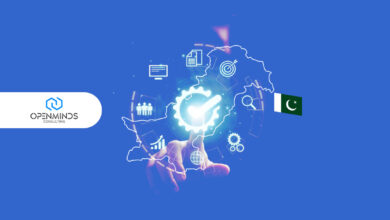Disruption or Digitization?
Recently, “Digitization”, “Digital Transformation”, “Disruption”, “Innovation” and other related buzzwords such as “Digital Divide” have seen a surge in the policy discussion space. For the purpose of clarity, such terms need to be narrowed down. For now, let’s pick “Digital Transformation” and break it down into micro and macro factors.
At the firm level (micro), the term can be defined as transforming the entire organization to be able to cope with current and future challenges through digital know-hows. Innovative technologies are not the only factor. The firm also has to put in place the processes via which adoption of innovative and digital technologies can be encouraged, with the objective of increasing operational efficiency and cutting down costs. Examples include adopting enterprise resource planning (ERP), utilizing the internet to conduct transactions, making use of robotics or artificial intelligence in production processes etc.
At the country level (macro), the term defines how the internet economy and digitization of firms is transforming the entire country and is contributing to macroeconomic indicators, primarily growth and income. A country going through such a transformation is considered a digitized economy and is characterized by features such as tech-savvy population as measured by skill and education level and extensive adoption of digital services by the government and businesses. Recently, Estonia, along with Finland and Norway, has been declared the most digital country in the world.
The Sad State of Affairs!
Digitization at micro and macro level is a necessary contributor to a country’s Global Competitiveness Index (GCI) ranking which provides a detailed map of the factors and attributes that drive total factor productivity, growth and human development. However, for governments and businesses to take advantage of “Digital Transformation”, the primary requirement is the presence of digital ecosystem, which is itself dependent on digital inputs. The internet, being the most important input, without which nothing “Digital” can exist.
According to GCI, Pakistan ranks 110 out of 141 economies, above Nigeria and Laos and below Kenya and Bangladesh. A component of GCI, measuring the country’s “Digital Transformation”, the ICT adoption index ranks Pakistan 131, only 10 places above the lowest ranked country, Chad. The ICT index itself consists of variables such as internet users and mobile cellular subscriptions, both of which score at the lowest brackets.
Global Competitiveness Index 4.0 2019 edition (rank out of 141)
Pakistan lags behind regional peers in Information Technology adoption
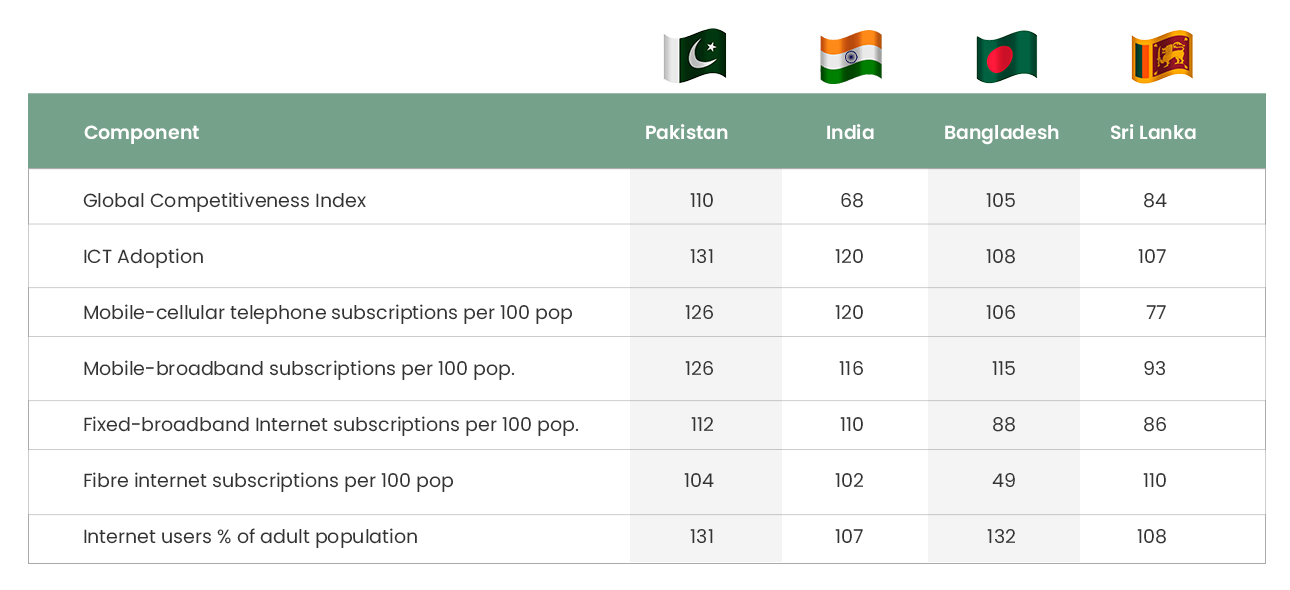
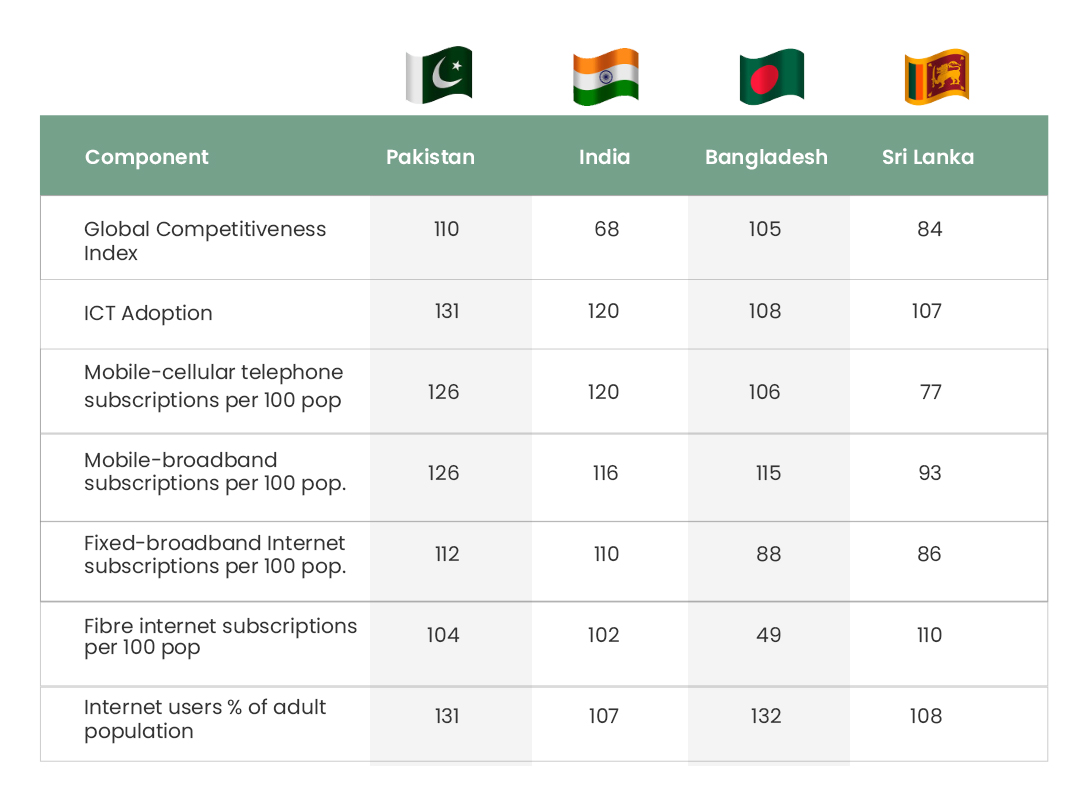
Source: Global Competitiveness Report 2019, World Economic Forum
Pakistan might rank low on the scores, however, rarely do such indexes take into account the regional disparities, which are rampant in case of an emerging economy like Pakistan. Such distinctions are necessary if policy makers and businesses are to identify the root causes of low ICT score and take measures to address the digital divide in the country.
My neighbor cannot access Netflix!
With smartphone penetration as a share of connections of just 51% this year, Pakistan lags behind regional peers such as India and Bangladesh, in the vital determinant of Digitization of the country. Despite that, internet users grew by an average of 15% over the last 5 years, standing at 80 million users as of August 2020. The rapid surge in the internet usage is mostly led by young urban middle class of Karachi, Lahore and Islamabad. The federal capital, for example, accounts for 25% of twitter users in the country, more than the combined users of Baluchistan and Khyber Pakhtunkhwa. Further evidence of unequal growth in the internet users can by seen by analyzing the provincial e-commerce traffic. As of 2020, Karachi, Lahore and Islamabad contributed 52% to the total e-orders made. Karachi’s Gulshan Iqbal alone surpassed Quetta in this . While Sialkot, Multan and Hyderabad experienced a higher growth in e-retail and e-payments, the adoption even in urban centers of Balochistan and Khyber Pakhtunkhwa mostly remained stalled.
Relax it is just 25%
Nearly 85% of the population lives in the plains of Punjab, Sindh and vale of Peshawar, the rest resides in sparse settlements of Gilgit-Baltistan, Khyber Pakhtunkhwa and Baluchistan. Over 25% of them are not well connected and accessible. One can argue that the primary cause of the digital divide and unequal digital growth is due to population; however, per-capita figures dispute this. While it is true that sparsely populated districts with low density have little incentive for the private sector investments to provide internet services, it is mostly other factors which are responsible for attracting such investments. When it comes to e-retail, e-commerce or even e-learning, the urban centers of Punjab and Sindh along with Islamabad perform much better than the rest of the country. Islamabad, for example, has twice more e-payments relative to Quetta, even though the latter has a higher population density (5600 per km2) than the former (2089 per km2).
Population density by district in Pakistan
Unequal digital growth cannot be explained by population density alone

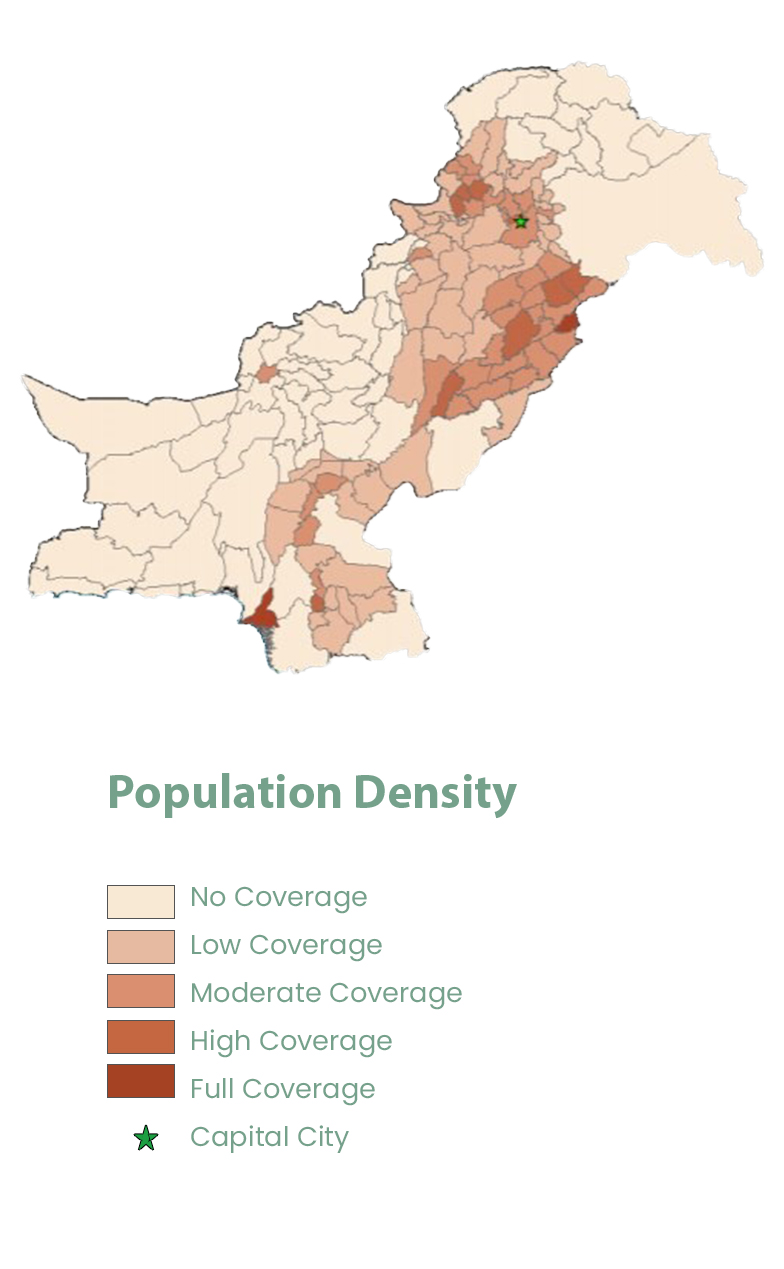
Source: The Fletcher School, Tufts University
4G without Cell Towers?
According to Economist Intelligence Unit, Pakistan ranks 76 out of 100 in Internet Inclusiveness Index and almost last Asia. Outside the big cities in Punjab and Sindh, there is little or no internet coverage. According to the country’s minister for telecommunications, 35% of the country lacks the much-needed internet infrastructure. This includes connections to optical fiber and lack of telecommunications towers. Province wise breakdown shows that nearly 60% of Baluchistan is not covered by the internet. Similar numbers can be expected in Gilgit-Baltistan and formerly F.A.T.A areas. While some areas have adequate coverage, internet speeds in such districts are lower than the national average of 6.2 Mbits per second (cellular only). In some areas, the download speed was recorded was less than 1 Mbits.
Existing 4G Coverage in Pakistan
Nearly 60% of Baluchistan does not have internet coverage

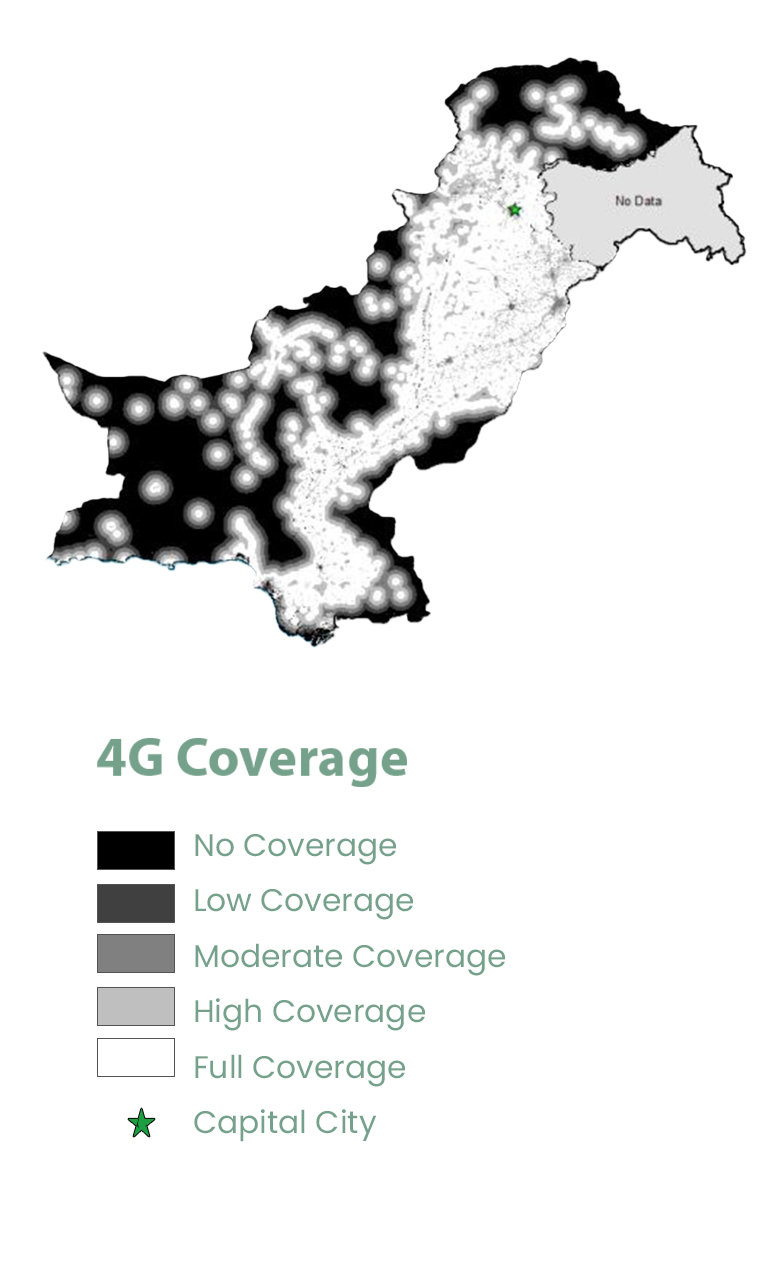
Source: The Fletcher School, Tufts University
Blame the mountains!
It is true that areas which lack digital connectivity also fall short on infrastructural investments, mostly because such areas are harder to reach due to rough terrain. Let it be Lasbela in Baluchistan or Parachinar in Khyber Pakhtunkhwa, mountainous landscapes, unpaved roads and widely dispersed towns have resulted in little to no investment by private telecommunication firms. With the average elevation of 2000 feet, terrain in Baluchistan is extremely difficult for construction as opposed to 590 feet and 686 feet in Punjab and Sindh. Thus, while the rest of the country, mostly plain urban Punjab along with Karachi, Hyderabad and Islamabad lead the way in internet coverage, millions in difficult to reach areas continue to be excluded from participating in the information revolution.
Elevation and slope of landmasses in Pakistan
Terrain in most parts of Baluchistan and the North are not conducive to infrastructure investment

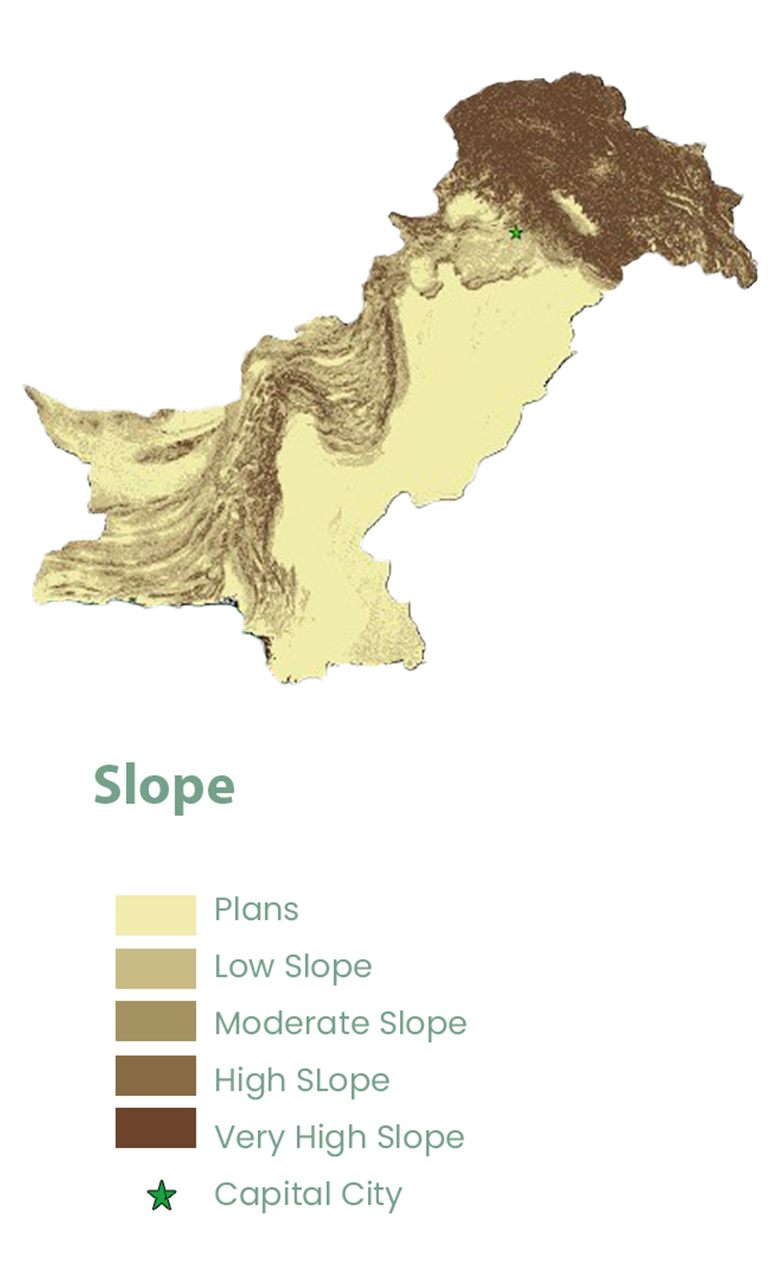
Source: The Fletcher School, Tufts University
All-weather friend comes to the rescue?
With $62 billion being invested by China in promoting regional connectivity as part of China-Pakistan Economic Corridor, Pakistan has seen an unprecedented boom in the construction of motorways and railways, which is expected to significantly enhance the market accessibility to otherwise disconnected areas such as Makran belt in Baluchistan. Establishment of special economic zones such as Rashakai in Khyber Pakhtunkhwa and Moqpondass in Gilgit-Baltistan will see a flow of commercial and industrial activities in previously inaccessible areas. With the state providing the much-needed infrastructure along with financial enticements, the incentive for telecommunication companies to expand into such regions is expected to rise.
At The Fletcher School of Law and Diplomacy, Tufts University, I combined the population density, existing 4G coverage, elevation and road network data to come up with a suitability map designed to aid the state and telecommunication firms to identify the areas suitable to build new 4G towers. The suitability map, which helps address the issue of digital divide in Pakistan, was created using GIS software.
What to do?
Areas suitable to build new 4G towers in Pakistan
Large parts of Balochistan are highly suitable for IT infrastructure

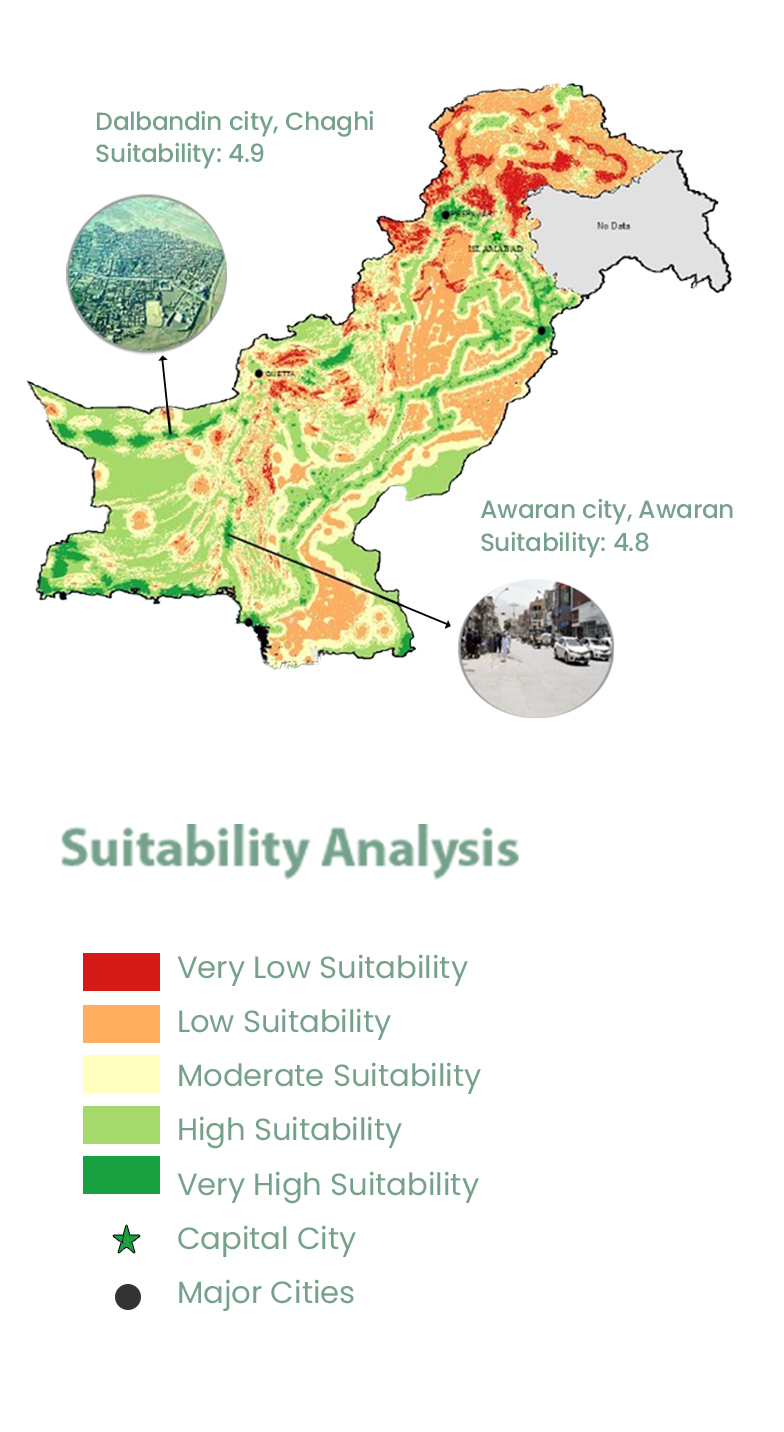
Source: The Fletcher School, Tufts University
For Pakistan to undergo “Digital Transformation” at both micro and macro level, an important aspect is to improve the 4G coverage, which will lead to an increase country’s ICT score, resulting in enhancing the Global Competitiveness Index and thus setting up the country for much-needed GDP growth via providing a boost to total factor productivity. The key to improve the 4G coverage is to provide financial and non-financial incentives to the private sector telecommunication firms to build 4G towers in areas, with high suitability. Top 10 districts lacking IT infrastructure with highest suitability scores are listed below:

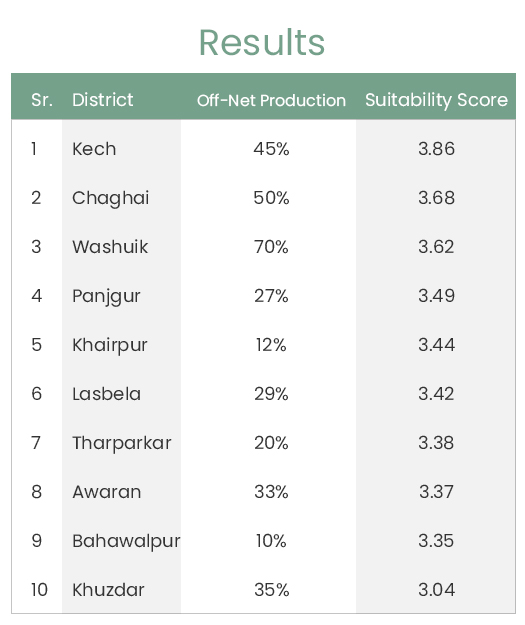
Suitability analysis can be found by a combination of population density, existing 4G coverage, slope and road network. As can be seen above, most areas of Baluchistan province are highly suitable to build existing 4G towers, especially on the Southern region. Out of the top 10 districts with highest suitability score, 7 are located in Baluchistan. With off-net population as high as 70% in Washuk in South Western Baluchistan, there is a dire need to close the digital divide in the largest province of the country.


